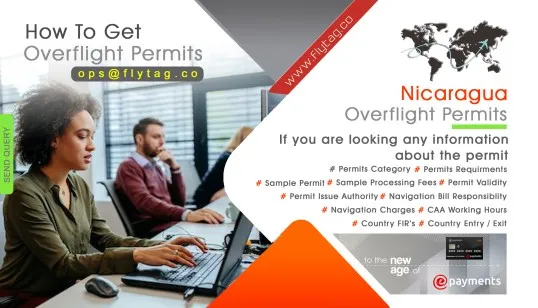Nicaragua Overflight Permits
 Nicaragua overflight permits approval required for all airlines, private jets, air ambulances, cargo, and passenger flights, permits can also be arranged on short notice.
Nicaragua overflight permits approval required for all airlines, private jets, air ambulances, cargo, and passenger flights, permits can also be arranged on short notice.
If you're an operator of a business jet or a commercial airline with plans to flyover Honduras airspace, obtaining a Honduras Overflight Permit from the Honduras Civil Aviation Authority (CAA) is mandatory. As a flight dispatcher, it's important to have a good understanding of the requirements for obtaining this permit, including the fact that the issuing of an overflight permit confirms that there is no political or security objection to your airline, aircraft, or country of origin/destination and that there are no outstanding navigation fees due to the ATC authority.
The issued overflight permit number must be inserted in Item 18 of your submiting Flight Plan.
Honduras Overfly Permit : RMK/HONDURAS OVF AHACHN-865.
Officially there is "NO CAA Processing Fees" applied for issuance of Honduras Overflight Permit.
At our company, we recognize that top-notch, personalized ground handling services at an affordable cost are crucial to a successful flight, regardless of whether it's scheduled or ad-hoc. Our priority is to ensure that the aircraft, its crew, passengers, and cargo receive excellent care from the moment of landing to takeoff. We provide a comprehensive selection of cargo, ramp, passenger, and fuel stop services, both within Honduras and at various global destinations, to deliver a seamless experience to our customers.
 Nicaragua overflight permits approval required for all airlines, private jets, air ambulances, cargo, and passenger flights, permits can also be arranged on short notice.
Nicaragua overflight permits approval required for all airlines, private jets, air ambulances, cargo, and passenger flights, permits can also be arranged on short notice.
 Belize overflight permits approval required for all airlines, private jets, air ambulances, cargo, and passenger flights, permits can also be arranged on short notice.
Belize overflight permits approval required for all airlines, private jets, air ambulances, cargo, and passenger flights, permits can also be arranged on short notice.
Our highly professional flight support team with more than 15 years’ experience has the commercial technical and regulatory knowledge with expertise that enables us to handle your flight in the shortest possible time at any civil airport in Honduras
Help to reduce the inconveniences of international flights such as obtaining Honduras overflight & landing permits, escorting of passengers, crew through customs, and immigration. Arranging other services by third-party suppliers.
We adhere to strict operating and customer service standards that result in consistent, professional, and personalized service at every location we serve. We can tailor our products to the specific needs of each of our customers, offering all, or a mix of services.
we backed by hundreds of trained agents and handlers worldwide with a dedicated team of professionals who are committed to safety, customer satisfaction, and quality, we always have a solution if you can harness the right resources.
Our operations center with its 20 strong team strengths of dispatchers and flight coordinators is on duty 24/7 to meet your every need.
Our skilled flight support team provides extensive international travel support services for flight clearance requirements in Honduras airspace.
You can contact us and our international travel support team will provide you with a full overflight permit fee within 5 minutes.
We have direct contacts with worldwide Civil Aviation Authorities (CAA) and in some countries in which CAA is only allowed to process permits through local agents, we have a very professional local representative team available to support our valued customers so that we would be able to arrange landing permits on a short term notice period.
Before applying for an overflight permit, please refer to the following details that may help you understand.
Our services include international trip planning, overflight permits, landing permits, traffic permits, ground handling, real-time flight watch, JetA1 fuel, catering uplift, weather & notams, crew hotel, and any other services requested by the airline/operator.
Honduras is a Central American country with Caribbean Sea coastlines to the north and the Pacific Ocean to the south. In the tropical rainforest near Guatemala, the ancient Mayan ceremonial site Copán has stone-carved hieroglyphics and stelae, tall stone monuments. In the Caribbean Sea are the Bay Islands, a diving destination that's part of the 1,000km-long Mesoamerican Barrier Reef.
The Copán ruins are an ancient Maya site discovered in 1570 by Diego García de Palacio. Now a UNESCO World Heritage Site, this area was deeply important as a political, civil, and religious center of the Copan Valley. The city was occupied by Maya for around 2,000 years, and it was abandoned in the 10th century. The site wasn’t excavated until the 19th century, and now you can wander through the vast area and learn about the history of the ancient civilization. Visit the site to explore the Maya citadel, where you’ll see portrait-style stone monuments called stelae, overlapping step-pyramids, and many ruined buildings.
Pico Bonito National Park is located in the Nobre de Dios mountain range, bordered in by Dole pineapple plantations, cattle farms, and the Rio Santiago and Cangrejal rivers. Inside the park is a mountain peak that reaches up to 2,435 meters above sea level, and the park’s plant and wildlife vary from the tropical forests in the valleys to the high-elevation cloud forests on the peaks. A popular destination within the park is The Lodge at Pico Bonito, a privately owned eco-lodge that is surrounded by lush wildlife and forestry and offers tours and other outdoor adventures like kayaking or whitewater rafting. Pico Bonito is regarded as one of the best parks for outdoor activities in Honduras.
Utila is a lovely island in the Bay Islands of Honduras that formed its reputation on affordable and abundant diving facilities. Although the prices aren’t quite as good as they used to be, it’s still the best place to go to spot young whale sharks and majestic coral reefs. Utila is a popular destination with young backpackers because of its somewhat cheap accommodation – the small island is filled with all kinds of hotels, restaurants, and bars along the few designated roads. Much of the island isn’t developed and to access those areas you’ll need to travel by sea.
This park is named after the environmental activist Jeannette Kawas who was murdered after fighting to get this land-protected status as a national park. It’s bursting with wildlife, from howler and white-faced monkeys on land, to manatees and marine turtles in the sea, plus more than 100 species of birds in the air. The surroundings is just as varied, with lagoons, coral reefs, tropical rainforests, swamps, and wetlands. Boat trips along the Río Ulúa are available to give travelers a chance to see the wildlife close up. Extreme adventurers might want to rent their own boat or hike solo, but more relaxed travelers can stick to an organized tour or ramble along the beautiful sandy beaches.
Roatán is a long, thin Bay Island that has seen a boom in tourism development in recent years compared to the other islands. Diving and snorkeling among the abundant coral reefs are probably what people come here for most; West Bay is a popular place for travelers to stay – hotels range from budget options to more exclusive pricey stays. Although its beaches are its main draw, Roatán also has mountainous areas where pine trees shade the land, and the east side of the island is still relatively remote and unexplored.
Lake Yojoa, located in a cavity formed by volcanoes long ago, is the largest lake in Honduras with a surface area of 79 km. The lake is conveniently located along a highway that travels between Tegucigalpa and San Pedro Sula, two of the country’s largest cities. The highway makes accessing the lake easy, and it is a perfectly located pitstop for those traveling between the cities. The beautiful, lush landscape is threatened by deforestation, cattle ranching, and developing. Enjoy the area by taking a fishing break near the lake, visiting the restaurants on the banks, birdwatching (nearly 500 species of bird have seen around the lake), visiting the nearby coffee plantations, or hiking to remote waterfalls or mountain summits.
Comayagua is a city also along the highway between Tegucigalpa and San Pedro Sula that is famous for its array of Spanish colonial architecture. The town is at an elevation of 594 meters above sea level, and it is the former capital of Honduras. The city was an important place for politics and religion until it lost its title as the capital in 1880. Wander through the small city for a quick view of the stunning architecture. In the central square is a beautiful cathedral with the oldest clock in the Americas, and the 16th-century Neoclassical-style city hall is also impressive. The city is still ingrained with catholic traditions, and it is a great place to witness Easter celebrations.
This reserve is a UNESCO World Heritage Site and one of the best places to see the plants and animals of Central America’s tropical rainforest. Along with the thick rainforests, open savannas, and mountainous regions, this area is home to more than 2,000 indigenous people and many important archeological sites. According to UNESCO, the reserve hosts 586 species of vascular plants in the low lands, 721 species of vertebrates, including many endangered and vulnerable species, 411 recorded species of birds, and about 108 species of reptiles and amphibians, including several species of poisonous snakes. Guided tours and camping trips are the best way to see the most of this reserve.
The Mosquitia houses the biosphere reserve, and it is one of the country’s last fully undeveloped areas. Visits are reserved for the most adventurous travelers as the living conditions can be euphemistically described as ‘rustic.’ This area of swampy mangroves, untouched rainforests, and wild coastlines makes up almost a fifth of the entire country, and yet it only has two real roads and a modest population of indigenous peoples. You’ll find incredible wildlife, fantastic nature views, and a thriving local culture. Visiting The Mosquitia is the best way to escape modern life and live like a true traveler.
This national park is another well-conserved area of Honduras located behind the city of San Pedro Sula. It’s no easy task getting into the park as many roads can be inaccessible, but you can get the most out of your trip by hiring a local guide to help you navigate the forest and find tropical birds and other wildlife. More than 260 species of bird have been spotted in the park. The best time to see the most wildlife is early morning, and from April to June is the best timeframe to spot parrots, toucans, and quetzals.